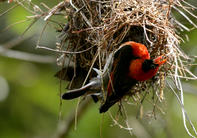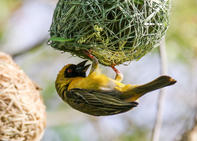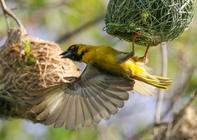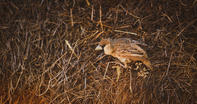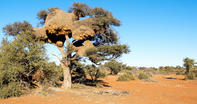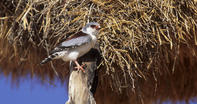Females Are Choosy
To attract females, male weaver birds go to extreme lengths. Since the ultimate selection of a mate is usually up to the female, the male weavers leave nothing to chance in their construction of delicately and expertly woven homes.
These they show off to passing females, flagging them down with vigorous displays and their brightly coloured costumes. Females will inspect the nests and finding them to their satisfaction will begin to line the interiors as an indication of their approval. Mating will follow. If a nest is continually rejected by female passers-by, the male will destroy it and begin again. It is critical that the material used is fresh and green and that the quality of the weave is masterful.
Some species of weaver build their nests in colonies over water where they are afforded a degree of protection from predators. Others like the red-headed weaver are fairly resourceful often making use of telephone wires or electric pylons. Red-headed weavers have the untidiest of all the weaver nests but they are constructed of twigs rather than fine grasses and palm leaves.
Stick Nests
Red-billed buffalo weavers live communally in large stick constructions built and defended by a single dominant male. These nests are sturdy and last many years as the material used can be up to four times the size of the builder. Within the nest, individual chambers are constructed connecting to the outside by a tunnel. The male invites many different females to occupy each of these chambers by fluttering his drooped wings for them.
If a female should comply, the pair will mate and she will line her portion of the nest with greenery and proceed to incubate and care for her offspring alone. Copulation in red-billed buffalo weavers is unique amongst birds for it can last for up to two minutes,for most species it takes just seconds. The male birds have a permanently erect phalloid organ, which enlarges further during the breeding season and seems to facilitate the process although it is not a penis.
The nests of the buffalo weavers are usually positioned on the western or north-western side of a large tree and can be used to help orientate oneself in the bush on a sunless day. Verreaux’s eagle-owls and white-backed vultures may also benefit from these nests using them as ready-made platforms for their own nesting needs.
Communal Nests
Nest construction in weavers usually begins with the male instigating the activity and the mate adding the finishing touches. Some weavers, like the sociable weaver, however, form cooperative breeding groups, where numerous pairs build a huge communal nest together.
A communal nest has several advantages over an individual nest. Safety in numbers is probably the greatest advantage, where strength in numbers applies. Having a single large nest in a tree, ensures that predators can be more easily spotted as they approach the nest. The large colonial nest of the sociable weaver has several chambers inside, with each chamber belonging to a different breeding pair.
Unlike the other weaver males, that are polygynous, where one male builds many nests for a variety of females in order to breed with them, sociable weavers are monogamous. Colonialism does not occur in polyandrous species.
